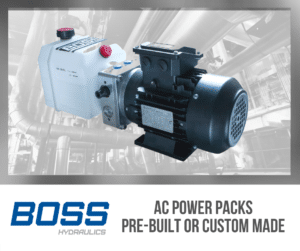Choosing the Right Hydraulic Power Pack
There are many available options and configurations of Hydraulic Power Packs, so it’s important to understand how to choose the right pack or components. It is important to start by defining what the nominal power required will be according to the desired flow rate and pressure, which depends on the effort that is required to be applied.
- Nominal power: indicated in watts (W) or kilowatts (kW), it is the power of the motor that drives the hydraulic pump.
- Nominal flow rate: expressed in litres per second (l/s) or litres per minute (l/min), it is the volume of liquid that the pump can send into the system in a given time.
- Nominal pressure: expressed in pascals (Pa) or bars, is the force that the hydraulic unit can withstand and depends on the power of the engine.
It is essential to correctly calculate the power requirements for your unit because excessive pressure can damage components of the hydraulic system or if the unit is not powerful enough, it will not be able to operate the equipment that it is intended to drive. Correctly estimating the size of the tank is also important as the capacity of the tank must be sufficient to supply the entire hydraulic system and meet the desired flow utilization rates.
It is also important to consider whether the unit will be used continuously or intermittent. A power unit that is designed for intermittent use should not be used continuously as this may result in overheating of the motor. Consideration can then be given to the energy source to power the unit, which could be electric, petrol, diesel or air driven.
The BOSS offering hydraulic power units come in a range of pre-built configurations or can be customised to suit your requirements with various valves, tank sizes, power options and flow rates. Our team of Hydraulic experts can design and build a custom solution to suit your specific requirements so you can… let your BOSS do the hard work.

